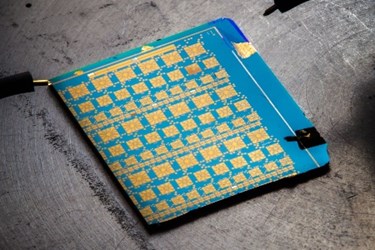RF MEMS: New Possibilities For Smartphones

The antennas in most of today's smartphones do not function efficiently in 3G and 4G/LTE wireless environments. This leads to slower download speeds, reduced voice quality, lower energy efficiency and more dropped calls. A technology commonly used in satellite and defense applications-RF MEMS or Radio Frequency Micro-Electro-Mechanical Systems-is now poised to improve smartphone performance in the near future by way of higher antenna efficiency.
"If you can make smartphone antennas 2 or 3 dB more efficient, you basically halve your download times. Truly, if we accomplish this with RF MEMS technologies, it's a huge deal," said electrical engineering professor Gabriel Rebeiz. His labs have accomplished many fundamental RF MEMS research breakthroughs, created proof-of-concept applications, and led key technology transfer efforts. This work has advanced RF MEMS to the point where large-scale incorporation into smartphone antennas appears probable if not inevitable.
"We demonstrated that you can get a better antenna, a better filter, a better power amplifier using RF MEMS. These were the first demonstrations. Industry took this work and adapted it to their own situations," said Rebeiz. He was awarded the 2014 IEEE Daniel E. Noble Award for Emerging Technologies "for pioneering contributions enabling commercialization of RF MEMS technology and tunable micro- and millimeter-wave systems."
A 2012 article in MEMS Journal predicted that the RF MEMS market would expand by a factor of 200 to $150M by 2015, driven by implementation in handsets and tablets.
In addition to antennas, RF MEMS technology could find its way into tunable filters for smartphone radios that might one day replace the tens of individual filters built into today's smartphones. With the rise of carrier aggregation-which is the use of multiple frequency channels to divide data, such as a video, that is being sent or downloaded in today's advanced wireless networks-filters are increasingly important, explained Bilgehan Avser, an electrical engineering graduate student in the Rebeiz lab.
"Metal-contact and capacitive switches could turn out to be extremely important for tunable RF front ends of next-generation communication systems," said Avser.
Cellphone base stations could also see RF MEMS implementations. But applications beyond tunable antennas could take more time to be implemented in commercial handsets and tablets, Rebeiz noted.
Tunable Antennas
In recent years, antenna size-and by extension radio frequency performance-has lost ground in phones to larger screens and thinner form factors that exclude larger antennas. At the same time, the demands placed on these antennas have increased. For example, even though antennas have gotten smaller, they are being asked to cover lower-frequency bands that would normally require larger antenna form factors.
 "The smartphone antenna, which has long been neglected, now is of prime importance for how to make the smartphone more efficient," said Rebeiz. Incorporating RF MEMS into smartphone antennas yields "tunable" antennas that work efficiently across one or two frequency bands at a time. The frequency at which they function most efficiently, however, can be changed-and RF MEMS metal-contact switches and variable capacitors are used to make the antennas tunable.
"The smartphone antenna, which has long been neglected, now is of prime importance for how to make the smartphone more efficient," said Rebeiz. Incorporating RF MEMS into smartphone antennas yields "tunable" antennas that work efficiently across one or two frequency bands at a time. The frequency at which they function most efficiently, however, can be changed-and RF MEMS metal-contact switches and variable capacitors are used to make the antennas tunable.
"With RF MEMS, you can take an inefficient wideband antenna and turn it into an efficient tuned antenna," said Rebeiz. In this context, RF MEMS serves as a low-loss switched variable capacitor capable of changing the antenna's resonant frequency, which is the frequency at which the antenna operates most efficiently.
Rebeiz has been a leader in RF MEMS research for more than a decade. Much of the early research focused on defense and satellite communication applications such as phased-array systems with sophisticated "beam steering" antennas. In this arena, RF MEMS technologies enable the electronic steering of multiple antennas that function together in order to steer signals to a precise location and ensure the signal does not interfere with other systems. Another application: rugged hand-held radios that work efficiently at many different wireless frequencies.
"We laid out the fundamental work to make RF MEMS a reality, through investigation of so many fundamental problems of MEMS. We solved a lot of these problems and transferred the advances to industry," said Rebeiz.
His research group's contributions include making MEMS robust in the face of process stresses incurred during micro-fabrication, as well as temperature extremes. They also helped demonstrate the vast potential that RF MEMS hold for commercial applications.
In September 2006, Rebeiz became the founding director of the UCSD/DARPA Center on RF MEMS Reliability and Design Fundamentals. As the leader of this eight-year collaboration between universities, the U.S. Federal Government and industry, Rebeiz works to ensure that knowledge on RF MEMS advances are widely available in order to further spur innovation.
Many of the graduate students who worked on RF MEMS projects while at UC San Diego are now working on related challenges in industry-at companies like Cavendish Kinetics and WiSpry that are commercializing RF MEMS technologies, and at companies such as Apple, Qualcomm, Intel and Samsung that are looking to incorporate RF MEMS and other tunable technologies into their products.
"Our RF MEMS work has been a good ride. It has been exactly what I feel research should be. You take a problem. You spend 12 to 14 years on it. You solve its fundamental issues. You transfer it to industry," said Rebeiz. "Have we solved all of the problems? No. But we have gone from 10 percent of understanding of RF MEMS to 90 percent."
Source: University of California
